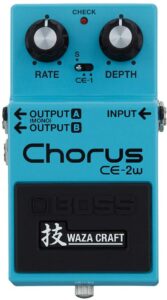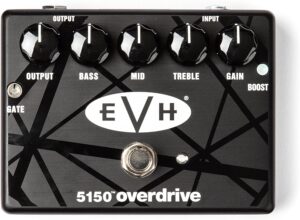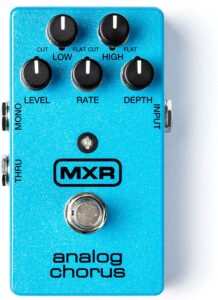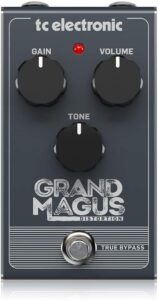How to find the best pedal for 80s hair metal? We know the correct answer and will help you make an informed decision.

The ’80s is regarded as the ‘golden age of heavy metal when legendary bassists including Eddie Van Halen, Stevie Ray Vaughan, and Frank Zappa bestrode the domain like a colossus.
If you want to emulate the tones of your favorite metal guitarist, then you’ll invariably need a premium distortion or chorus pedal. And when it comes to nailing hair metal (also called pop metal or glam metal) tunes, you require high gain and distortion levels.
Additionally, you’ll want greater sound compression for bridging the gap between rhythms, harmonics, and solos with evenly balanced volume output. Last but not least, you’ll have to strum with the right amount of intensity consistently without masking the notes.
This guide walks you through the five top-notch effects pedals that enable you to hit the right notes for 80s hair metal.
Best Pedals for 80s Hair Metal Tones (Comparison Table)
| Image | Model | Dimensions | Price |
|---|---|---|---|
 | Boss CE-2Waza Craft Metal (Top Pick) | 15.31 x 13.15 x 6.54 | Check Price |
 | MXR EVH5150 Overdrive Pedal (Close Runner-Up) | 5.5 x 4.5 x 2.5 | Check Price |
 | TC Electronic/Fangs Metal (Best on a Budget) | 5.2 x 2.91 x 2.28 | Check Price |
 | MXR M234 Analog Chorus Pedal | 2.6 x 5.5 x 4.4 | Check Price |
 | TC Electronic Grand Magus | 5.2 x 2.91 x 2.28 | Check Price |
1. Boss CE-2Waza Craft Metal (Editor’s Choice)
In our opinion, the CE-2 Waza is the best pedal for 80s hair metal available on the market at the moment.
The CEC chorus collection introduced in 1976 was Boss’s first pedal and the first chorus pedal worldwide. The super-compact Boss CE-2 chorus pedal, which came out three years later, integrated the original chorus pedal’s sound and continues to be supremely popular. Musicians and players the world over still rave about Boss’s chorus pedals’ riveting and spellbinding modulated tone effect.
To commemorate the 40th anniversary of its first chorus pedal, Boss has brought out the Waza Craft Metal that integrates the best of both CE-1 and CE-2. Supremely compatible for use with electric basses, the CE-2 Waza features one vibrato mode and dual chorus modes in a compact enclosure. While the two CE-1 modes emulate the timbre and tenor of the vintage CE-1, the Standard mode closely reproduces the initial mono CE-2’s sound.
At the same time, the CE-2W comes equipped with some additional features besides incorporating the top functionalities of CE-1 and CE-2. For instance, the CE-2 Waza has two built-in output jacks for an all-embracing stereo sound in the CE-2 setting, letting you direct your signal to two amps. On the other hand, you have the adjustable chorus depth control if you prefer dialing in the mono chorus effect of CE-1.
Pros
- CE-2W special edition chorus pedal uses an all-analog circuitry for recreating CE-1’s classic sound
- A simple flick of the toggle lets you move from vibrato and chorus effects of CE-1 to standardized CE-2 tone
- Rate and depth controls for delivering excellent modulation of sound in mono and stereo modes
Cons
- Wolfs down 9V batteries; plug this pedal into an electrical socket.
2. MXR EVH5150 Overdrive Pedal (Close Runner-Up)
Thanks to the collaborative effort of Eddie Van Halen and MXR’s design team, hyper-driven tones, and full-on saturation are now at your fingertips. So whether you’re inside a recording studio or gigging, please make the most of the EVH 5150 overdrive pedal for reproducing Eddie’s ultra-articulate high-gain tunes to his pioneering vintage tones. This MXR overdrive pedal perfectly and seamlessly blends hand-modulated multistage MOSFET sounds with harmonizing controls. In addition, it delivers overdriven tube-style tones via a wide range of speaker cabinets and amps.
While the 3-band passive tone load-up EQ section facilitates customized sound shaping, the output and gain knobs help dial-in volume and distortion levels. Use the boost switch for thrusting the EVH into stratospheric territory, where you take advantage of extra compression and gain. And if you want to steer clear of excessive noise, use the gate reinforced by a smart gate circuit.
Featuring true signal bypass, the EVH5150 Overdrive Pedal comes encased inside a durable enclosure displaying signature EVH illustration. With full-on overdrive and tube-driven amp-style feel, the EVH5150 mimics the legendary rock guitarist’s signature sound as perfectly as possible.
Pros
- User-friendly and easy to install: Yellow glow indicates pedal is in ‘off’ mode, and there’s no hiss
- Tempering the signal with some group delay and phase delay helps replicate the original ‘classic’ sound
- The brawny overdrive delivers sizzling crunchy notes tottering on the brink of distortion at a low gain (even without flicking the boost switch)
- The +6dB boost injects extra bite to your instrument’s sound
Cons
- It doesn’t capture the vintage effect as efficiently as EVH did
- Sounds way better when paired with a tube-amp vis-à-vis digital or modeling amps
3. MXR M234 Analog Chorus Pedal
The M234 Analog Chorus Pedal from MXR optimally exploits bucket-bridge circuitry for delivering luxuriant flowing textures that you cannot achieve with a digital pedal. Depth, Level, and Rate knob controls together with cut, flat cut, and flat controls let you accomplish total tonal control. Chorus pedals featuring a bucket bridge analog circuit under their hood guarantee the creation of thrilling and captivating chorus notes.
Tweak and modulate the rate, level, and depth controls for traversing the gamut of woozy spins to understated sparkles. The M234 Analog Chorus Pedal, like all other MXR pedals, is housed inside a lightweight yet sturdy and compact aluminum enclosure. As an analog pedal, the M234 excels in reproducing expansive soothing sound that modern-day digital pedals may not be able to deliver.
This analog chorus pedal has been redesigned with painstaking care enabling it to sound unusually fresh and sparkling. As a helpful feature, it also has an EQ preset alternative to effect-free clean sound! EQ and bass filters join forces, enabling you to personalize the chorus sound to suit your playing needs and preferences. At the same time, you can make good use of the EQ preset option if you want to nail the grimy sound.
Pros
- Dual output for a comprehensive and across-the-board stereo spread
- High and low cut knobs for meticulous and in-depth tone molding
- Compact design ensures pedal takes up minimal pedalboard space
- Analog bucket bride device for creating a magical chorus
Cons
- It doesn’t come with power supply hardware (so you’ll have to spend extra for that)
- Many players have reported that the MXR stereo pedal does better at ringing in the sultry yet seeping sweet chorus.
4. TC Electronic Grand Magus Distortion Pedal
Pepper your tunes with natural tube-like distortion typified by organic sag and taut bottom-end tone with the Grand Magus. With the TC Electronic Grand Magus Distortion Pedal, you can distill quintessential rock ‘n’ roll tunes. And get high by blending those notes with the essence of a classic tube-corrected power supply.
No other pedal can match up with the Grand Magus Distortion Pedal when recreating 80’s metal tunes. The Grand Magus has been designed meticulously to facilitate perfect alignment of fuzz stomps, distortion, and classic overdrive. You’ll be dialing in the ‘Holy Grail’ of rock ‘n’ roll when you ramp up the pedal’s gain past noon, offering you enough punch and viciousness for promoting mundane chords.
Use the ‘tone’ control for spanning the entire extent and spread from guttural and eloquent to swelteringly crusty, nearly imitating a treble booster. Reduce the gain if you’re looking for tube-style front-end rock-solid metal beats and perfectly evened-out raw gut-bucket blues. The Grand Magus comes encased in a sturdy metal housing which almost guarantees that this pedal will stay functional forever!
Pros
- True bypass switching goes a long way in optimizing tone on either side of the pedal’s beefy sustain
- Enables distortion, conventional overdrive, and fuzz treads to work in tandem
- Rich and warm mids along with buttery-smooth highs
Cons
- Several bassists have complained that there’s a discordant buzzing sound the moment the pedal is turned on.
5. TC Electronic/Fangs Metal Distortion Pedal (Best on a Budget)
Thanks to its versatility, the TC Electronic/Fangs Metal Distortion Pedal is your passport for entry to the realm of high-gain indulgence. The Fangs Metal Distortion, together with its multifaceted tone tools set, come in perfectly handy to let you mold your signature sound. This distortion pedal stompbox allows you to create everything from near-impregnable barricades of doom metal to super-taut thrash metal tones.
The Fangs Metal Distortion Pedal is priced significantly less than most high-end boutique pedals but can rival them performance-wise. You should be focusing on the midrange frequencies for achieving the sweet spot in your metal tones. TC Electronics’ Fangs Metal Distortion Pedal includes an intuitive midrange selector switch apart from featuring distinctive bass and treble knobs.
This selector switch offers you the leeway and the leverage to straddle the sweeping range of rock music genres and subgenres.
Pros
- Ultra-tight response
- True bypass for optimal signal integrity
- Perceptive midrange selector switch for across-the-board mids control
Cons
- The pedal gives off an unbearably loud hissing sound as long as it is on (controllable using bass knob)
How to Get 80s Hair Metal Tone?
So much has been written about nailing vintage 80s hair or glam metal tone, yet the debate rages on. Nevertheless, to keep things simple instead of losing your way in the labyrinthine maze of diverse opinions, abide by these steps to hit the nail on the head:-
- Keep your gain low as much as possible without sacrificing the fierceness of your instrument’s sound output
- Maintain the consistency in your attack while hitting the notes
- Refrain from scooping out the midrange frequencies
- Use the treble only if and when you need to (for spicing things up now and then)
- And the same goes for bass (use it in moderation)
- Let’s talk pedals. Keep in mind that the pedals act together with the amp/amps, so use the level knob for extra tone saturation while tautening the low end. Ensure to choose a pedal that comes with a noise gate for keeping out feedback and hum and maintaining the overall tonal tautness.
Conclusion: The Best Pedal for 80s Hair Metal Is…
So there you have it- 5 versatile pedals, including distortion, chorus, and overdrive pedals from Boss, MXR, and TC Electronics.
Guitarists specializing in the various genres and subgenres of rock ‘n’ roll, including metal have their specific preference when choosing distortion pedals.
Hence go through the reviews carefully before you take the plunge. Our winner is the CE-2W. It is the best pedal for 80s hair metal, in our opinion.